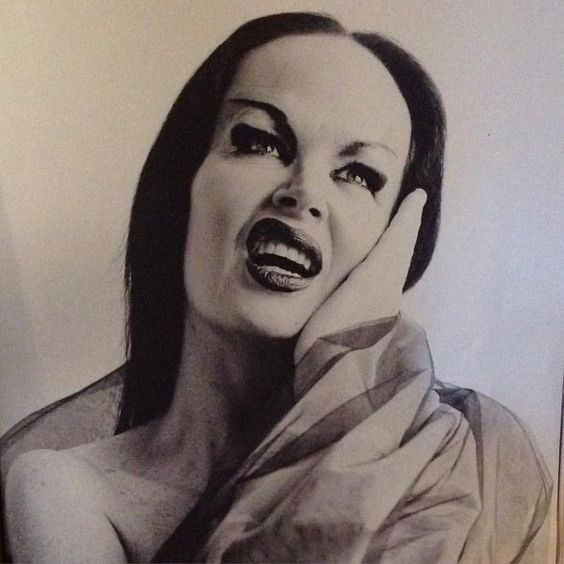We celebrate the artistic risk-taking of multihyphenate Kembra Pfahler, whose work – whether it disturbs or inspires – never ceases to take freedom of expression to the extreme
Kembra Pfahler is unafraid of making people uncomfortable with her art. In fact, the impulse to unsettle, provoke, and ultimately, make viewers think has long influenced her cross-platform projects since her early days in 1980s downtown New York. Throughout her varied career as a punk rock musician, performance artist, and curator, Pfahler has tried her hand at multiple art forms and left her indelible mark on on each one. Whether singing lead in the death punk-metal group The Voluptuous Horror of Karen Black (VHOKB), originating the “Availabilism” performance art movement, or — yes — having her vagina sewn shut while clad in little more than a “Young Republicans” shirt for Richard Kern’s short film Sewing Circle (1992), Pfahler mines absurdity and darkness as part of her political engagement. Today, we consider this controversial artist's raison d'être and the ways in which she has channeled her personal frustrations with society's treatment of women and their bodies into bold, powerful art.
Defining Features
A sense of visceral rawness is perpetually present in Pfahler’s appearance, whether she’s taking the stage to perform with VHOKB or donning her signature drawn-in eyebrows for art exhibition openings. Over the past few decades, Pfahler has crafted a glamorous persona all her own, one tinged with simultaneous nods to punk rock, haute couture, camp, and the grotesque. Her not-so-alter ego, Karen Black, allows Phaler to regularly engage in what she has called “an extreme visual presentation,” while also exploring her multifaceted artistic inclinations.
Pfahler treats her body — and often heavily made up face — as the canvas upon which her creative whims can take their fullest shape. Nudity plays a central role in her artistic expression, not as a provocative gimmick but rather as a means to increased vulnerability and confidence in public. While she draws inspiration from classic black-and-white horror films and German Expressionist aesthetics, it is the nightmarish monster under the bed or the witch casting spells on unsuspecting ex-lovers that more directly inform her look, as opposed to the innocent “final girl” trope. Whether she’s clad in little more than red body paint, black leather, or mesh, Pfahler’s physical appearance dares viewers not to look away.
Seminal Moments
Born into a free-spirited family (with a famous surfer father) in Hermosa Beach, California in 1961, Pfahler’s self-expression was encouraged from a young age. Her move to New York at age eighteen to attend the School of Visual Arts — where she studied under the tutelage of conceptual artists Mary Heilmann and Lorraine O’Grady — along with the debilitating AIDS epidemic that swept through the city and took many of her friends’ lives, marked the beginning of her veer into more extreme artistic territory.
While staking her claim within the burgeoning Lower East Side performance art scene, Pfahler formed VHOKB between 1989 and 1990. During their roughly ten years of touring, the band swiftly began to draw attention within the art and music worlds for their subversive spirit. As the founder of the artistic movement known as “Availablism,” based on the notion of using whatever presents itself at any given time, Phaler practiced what she preached during live performances, using such memorable quotidian objects as bowling balls and cracked eggs.

Beyond her band, Pfahler became a leading fixture within the underground Cinema of Transgression scene in the early 90s. From making a series of low-budget films to infamously appearing in the Richard Kern’s vagina sewing scene alongside performance artist Lisa Resurreccion — a move which, as she often jokingly claims, killed her career — Pfahler utilized film as a cathartic medium through which to channel her anger toward society’s gendered limitations.
Most recently, the now 54-year-old Pfahler was a founding voice behind Future Feminism, an exhibition-cum-performance series that ran at New York City’s The Hole Gallery in 2014. Pfahler and her diverse list of collaborators, ranging from Sierra and Bianca Casady of CocoRosie and Johanna Constantine of The Blacklips Performance Cult to Laurie Anderson and Marina Abramović, developed a radical artistic and feminist manifesto, ending with number 13: “The Future is Female.” For A/W16 she was cast in Marc Jacobs advertising campaign, shot by David Sims and appearing alongside icons including Sissy Spacek and Susan Sarandon – thus proving her cultural relevancy is as powerful today as it ever has been.
She’s AnOther Woman Because…
Pfahler’s work has originated a new language for beauty rooted in the unexpected — even if her version of beauty includes a nude body covered in red paint, Bride of Frankenstein hair, and an abundance of black eyeliner. Dissatisfied with easy answers, she never stops raising questions or probing the status quo in her uncompromising art and personal style. Indeed, Pfahler appears to be most comfortable when perched on the edge of mainstream acceptance while inviting curious viewers to peer over that edge and directly engage with the world around them. For this reason, we cannot wait to see what this brazen AnOther Woman does next, whether she’s fighting for women’s rights, religious freedom, or the ability to be fully oneself without facing violence or hostility. As Pfahler told The New York Times’ T Magazine in June 2012, “How do you fight these things? One show or concert at a time, I suppose.”
